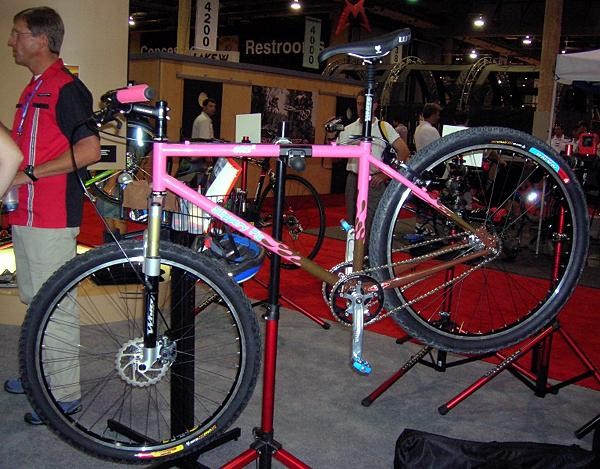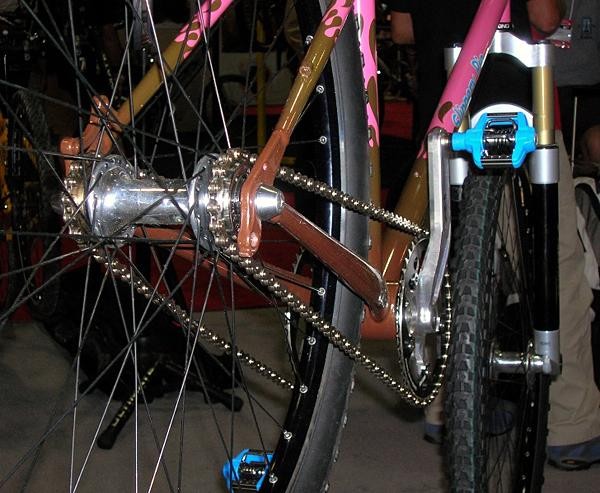Interbike: A retailer's eye
By Steve Medcroft Although it is a fascinating spectacle for anyone who is in love with cycling,...


By Steve Medcroft
Although it is a fascinating spectacle for anyone who is in love with cycling, Interbike is primarily a business trade show for the cycling industry. Manufacturers, dealers and vendors put out their wares in an attempt to impress retailers and other buyers. During (and in the past week since), Cyclingnews has attempted to bring you inside Interbike and show you what the industry has in store for you in the coming year. Since this is really a show for the retailer though, we thought we'd corner one and get his thoughts on what Interbike had to offer. The retailer we caught was Erik Angermeier, owner of Slippery Pig Bikes in Phoenix, Arizona. As well as attending the show as a retailer, Angermeier has an unusual two-niner bike design featuring dual drivetrains (called the Slippery Pig One-2) on display at the show.
Cyclingnews: What did you want to accomplish by going to Interbike this year?
Erik Angermeier: Variety is one of the reasons I go. We had an early-season intro to Trek and Kona at their facilities so I was going to Interbike to see the second and third-tier bike companies, see what they had to offer in comparison to the larger companies. I want to can see everything that's going to be out there in one place and do the comparisons. You get to see who has the best road, mountain or commuter bike, the best $400 bike, $500 bike and $1000 bike.
CN: Did you find what you were looking for?
EA: I found that I was paying attention to the companies that had a stronger complete line; who paid attention to the commuter as much as the $5000 road bike, to kids bikes as much as women-specific bikes. Jamis impressed me; they had a complete line from low end to high end and are actively trying to become a first-tier bike company. We saw what they had to offer and this morning I did a 50-bike order with Jamis because of what I saw in the trade show.
CN: Anything else stand out in particular?
Get The Leadout Newsletter
The latest race content, interviews, features, reviews and expert buying guides, direct to your inbox!
EA: The twenty-niner marketplace is increasing. When you see companies like DT create a wheelset and every major tire manufacturer offer the larger tires, you know a trend is taking hold. We're still not seeing the Specialized and Cannondale's jumping on board, though. Track bikes are poplar right now, too. It seemed like every major bike company had a singlespeed fixed gear track bike on display. Companies like Breezer had a good presence at the trade show as well; and their European-style commuter bikes sell well for us. A lot of companies are paying attention to the commuter now. Trek has the Navigator series. Lightweight road wheels in a mountain bike position with a lightweight aluminum frame; everybody's doing it.
CN: What about the traditional mountain bike?
EA: We went to Specialized, Santa Cruz and Cannonade and all of them had a six-inch travel mountain bike. And it seems like the standard cross-country suspension for a bike is now four inches. It used to be that five inch was the all-mountain bike - the Santa Cruz Heckler, the Gary Fisher Cake, Kona Dawg, Specialized Enduro. Then Fox came out with that 36 fork. It weights 5.1 pounds at 6 inches of travel and if you install it any five to six inch travel frame, the bike becomes so aggressive that you can ride it like a freeride bike. People are putting lightweight tires and cross country parts on these bikes and ending up with 30-pound bikes you ride either down a ski slope or take on an all-day trail ride.
CN: You're seeing a lot of demand for this all-mountain format?
EA: A lot of demand. The Santa Cruz Nomad is a hugely popular bike for us. And it's not because we (the retailers) drove the format. Consumer demand is changing. The information that's available on the web gets to the consumer before we ever get organized enough as a business group to showcase it. People knew about things that were at Interbike before I went to the show. For example, someone came in on Wednesday and said: "yeah, I saw the Niner (29-inch singlespeed boutique bike) online already."
CN: What has happened to the traditional mountain bike?
EA: Everything has moved up a class. The three-inch travel race bike almost doesn't exist any more; the race bike is now a four-inch travel bike. Specialized took the Epic from three to four inches. Kona on their race bike went from three to four. So now the four-inch bike, which kind of used to be the all mountain category, is considered cross country.
CN: You had a bike design of your own at the show (The Slippery Pig One-2, a two-niner with dual drivetrains)?
EA: It was popular. Because of the uniqueness of the drivetrain - whether they figured it was functional or not - everyone seemed at least curious about it.
CN: Why two drivetrains?
EA: The double chain is like a four wheel drive on a truck. It slightly engages forward progress a little more positively. It's a little stiffer. There's the mechanical advantage that if you broke a chain, you'd still be pedaling with the other side. You reduce frame flex because the frame is boxed out by the two chains, crankset and rear hub. The bike is symmetrical so it balances equally on both sides; when you let go of the handelbars, you don't have to countersteer to compensate for the weight of the drivetrain. The novelty of it is what catches people's eye though.
CN: Are you offering it to the mass market?
EA: Through the shop, I want to offer the drivetrain setup; the hub, two chains and the tandem cranks. A buyer will be able to choose the gear ratio they want and install it on any bicycle that has horizontal dropouts or an eccentric bottom bracket.
Cyclingnews' coverage of Interbike: